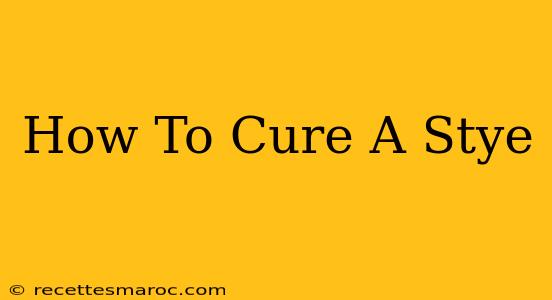A stye, or hordeolum, is a painful, red bump that forms on the eyelid. It's caused by an infected eyelash follicle or oil gland. While usually not serious, a stye can be irritating and uncomfortable. This comprehensive guide will explore effective ways to cure a stye, covering both home remedies and medical treatments.
Understanding Styes: Causes and Symptoms
Before diving into treatment, it's crucial to understand what causes a stye. The primary culprit is bacteria, often Staphylococcus aureus. This bacteria can infect the glands at the base of your eyelashes or in the eyelid itself.
Common symptoms of a stye include:
- Pain and tenderness: The affected area will be noticeably sore to the touch.
- Redness and swelling: The eyelid will appear red and inflamed.
- Pus: A yellowish pus-filled bump may develop.
- Itching: The area might feel itchy before the stye fully develops.
- Crusting: A crust may form on the eyelid.
- Blurred vision (rare): In severe cases, a large stye may temporarily affect your vision.
Home Remedies for Stye Treatment
Many home remedies can help alleviate stye symptoms and speed up healing. Remember, these are supplementary and not a replacement for medical advice if the stye is severe or persistent.
1. Warm Compress: The cornerstone of stye treatment
Applying a warm compress is often the first line of defense against a stye. The heat helps to soothe the inflammation and encourages drainage of the infection.
- How to: Soak a clean washcloth in warm (not hot) water. Wring out the excess water and gently apply the compress to your closed eyelid for 10-15 minutes, several times a day.
2. Cleanliness is Key: Preventing further infection
Maintaining impeccable hygiene is vital to prevent the spread of bacteria and promote healing.
- How to: Gently cleanse the affected area with a mild, fragrance-free cleanser. Avoid rubbing or touching your eyes excessively. Wash your hands thoroughly before and after touching your eyes.
3. Eyelid Hygiene: Removing debris and bacteria
Regularly cleaning your eyelids can help prevent future styes.
- How to: Use a clean washcloth and warm water to gently cleanse your eyelids, removing any crust or debris. Be extremely gentle to avoid further irritating the stye.
When to Seek Medical Attention
While most styes resolve on their own within a week or two with home treatment, you should consult a doctor if:
- The stye doesn't improve after a week of home treatment.
- The stye is excessively painful or large.
- You experience vision changes.
- You have multiple styes.
- You have other symptoms, such as fever or swollen lymph nodes.
Your doctor may prescribe antibiotic eye drops or ointment to help clear the infection. In rare cases, a small surgical procedure may be necessary to drain the stye.
Preventing Future Styes
Prevention is always better than cure. Here are some tips to reduce your risk of developing future styes:
- Practice good hygiene: Wash your hands frequently, especially before touching your eyes.
- Don't share makeup or towels: Bacteria can easily spread through shared personal items.
- Clean your makeup brushes regularly: Bacteria can accumulate on makeup brushes, leading to infection.
- Remove eye makeup before bed: Leaving makeup on overnight can clog pores and increase the risk of infection.
This guide offers a comprehensive overview of stye treatment. Remember to consult your doctor for persistent or severe symptoms. By following these tips, you can effectively treat a stye and reduce your risk of future occurrences.

